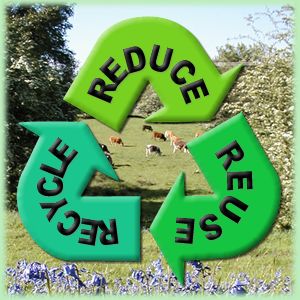Products that are recycled in large quantities include paper and paperboard, ferrous metals, aluminum and other nonferrous metals, glass, plastics, and yard wastes. Because the quality of recycled items is often inferior (often due to the mixture or age of the materials in the items being recycled) and not suitable for their original purpose, the price for many recycled materials remains low and makes recycling economically nonviable in some instances. In an attempt to solve this problem, new uses have been created for recovered waste material. Crushed glass, for instance, can be substituted for gravel or sand in road surfacing and other construction applications; the resulting product is called "glassphalt." Scientists and entrepreneurs are also working on ways to turn the world's growing piles of discarded automobile tires into new products or to use them to generate safe energy. Contamination of the recylates with other materials must be prevented to increase the recyclates' value and facilitate easier reprocessing for the ultimate recycling facility. This sorting can be performed either by the producer of the waste or within semi- or fully-automated materials recovery facilities.
Basically recycling consists of the following steps :-
Step 1. Collection and Processing
Collecting recyclables varies from community to community, but there are four primary methods: curbside, drop-off centers, buy-back centers, and deposit/refund programs. Regardless of the method used to collect the recyclables, the next leg of the journey is usually the same. Recyclables are sent to a materials recovery facility to be sorted and prepared into marketable commodities for manufacturing. Recyclables are bought and sold just like any other commodity, and prices for the materials change and fluctuate with the market.
Step 2. Manufacturing
Once cleaned and separated, the recyclables are ready to undergo the second part of the recycling loop. More and more of today's products are being manufactured with total or partial recycled content. Common household items that contain recycled materials include newspapers and paper towels; aluminum, plastic, and glass soft drink containers; steel cans; and plastic laundry detergent bottles. Recycled materials also are used in innovative applications such as recovered glass in roadway asphalt (glassphalt) or recovered plastic in carpeting, park benches, and pedestrian bridges.
Step 3. Purchasing Recycled Products
Purchasing recycled products completes the recycling loop. By "buying recycled goods," governments, as well as businesses and individual consumers, each play an important role in making the recycling process a success. As consumers demand more environmentally sound products, manufacturers will continue to meet that demand by producing high-quality recycled products.
Collecting recyclables varies from community to community, but there are four primary methods: curbside, drop-off centers, buy-back centers, and deposit/refund programs. Regardless of the method used to collect the recyclables, the next leg of the journey is usually the same. Recyclables are sent to a materials recovery facility to be sorted and prepared into marketable commodities for manufacturing. Recyclables are bought and sold just like any other commodity, and prices for the materials change and fluctuate with the market.
Step 2. Manufacturing
Once cleaned and separated, the recyclables are ready to undergo the second part of the recycling loop. More and more of today's products are being manufactured with total or partial recycled content. Common household items that contain recycled materials include newspapers and paper towels; aluminum, plastic, and glass soft drink containers; steel cans; and plastic laundry detergent bottles. Recycled materials also are used in innovative applications such as recovered glass in roadway asphalt (glassphalt) or recovered plastic in carpeting, park benches, and pedestrian bridges.
Step 3. Purchasing Recycled Products
Purchasing recycled products completes the recycling loop. By "buying recycled goods," governments, as well as businesses and individual consumers, each play an important role in making the recycling process a success. As consumers demand more environmentally sound products, manufacturers will continue to meet that demand by producing high-quality recycled products.




No comments:
Post a Comment